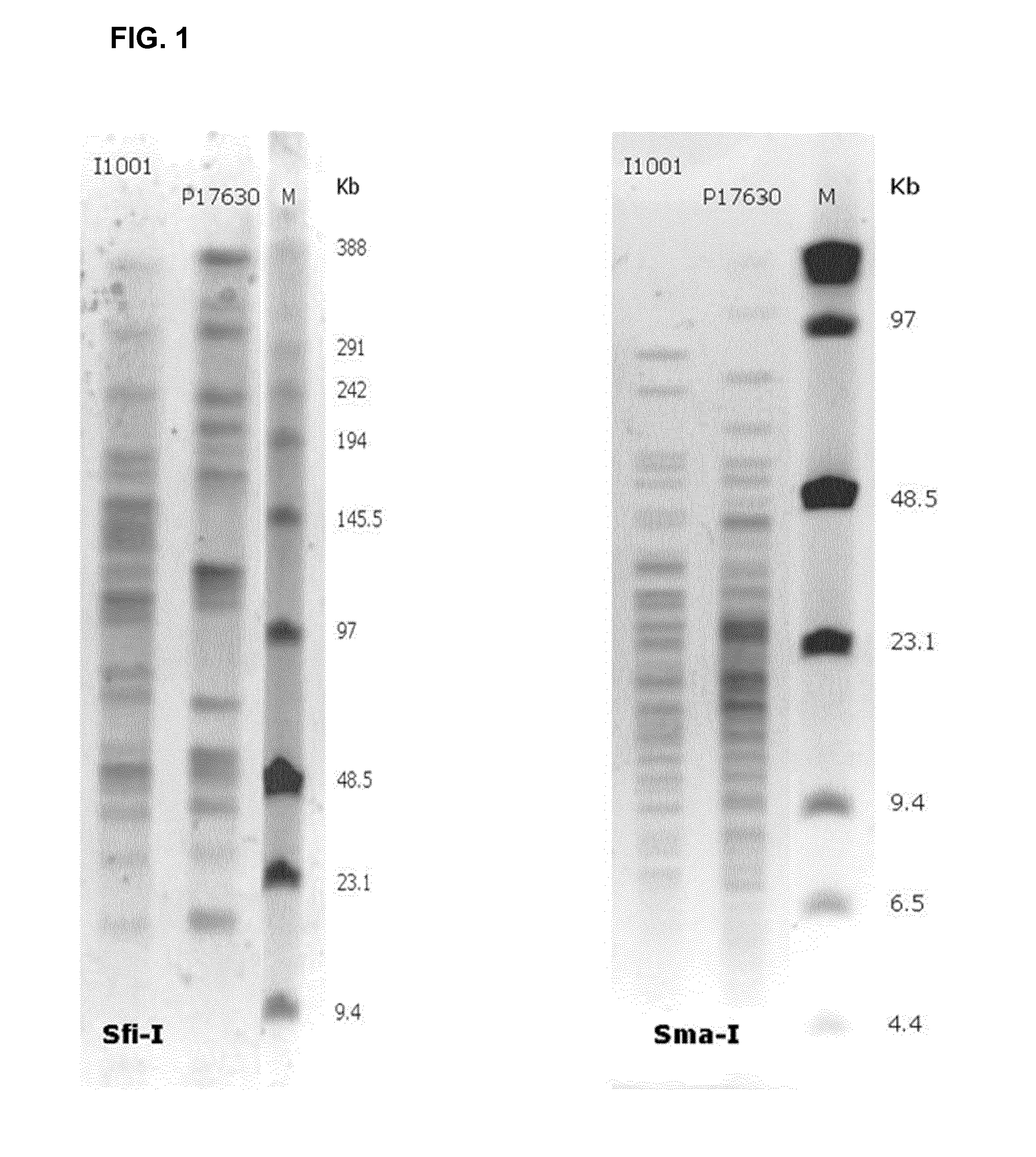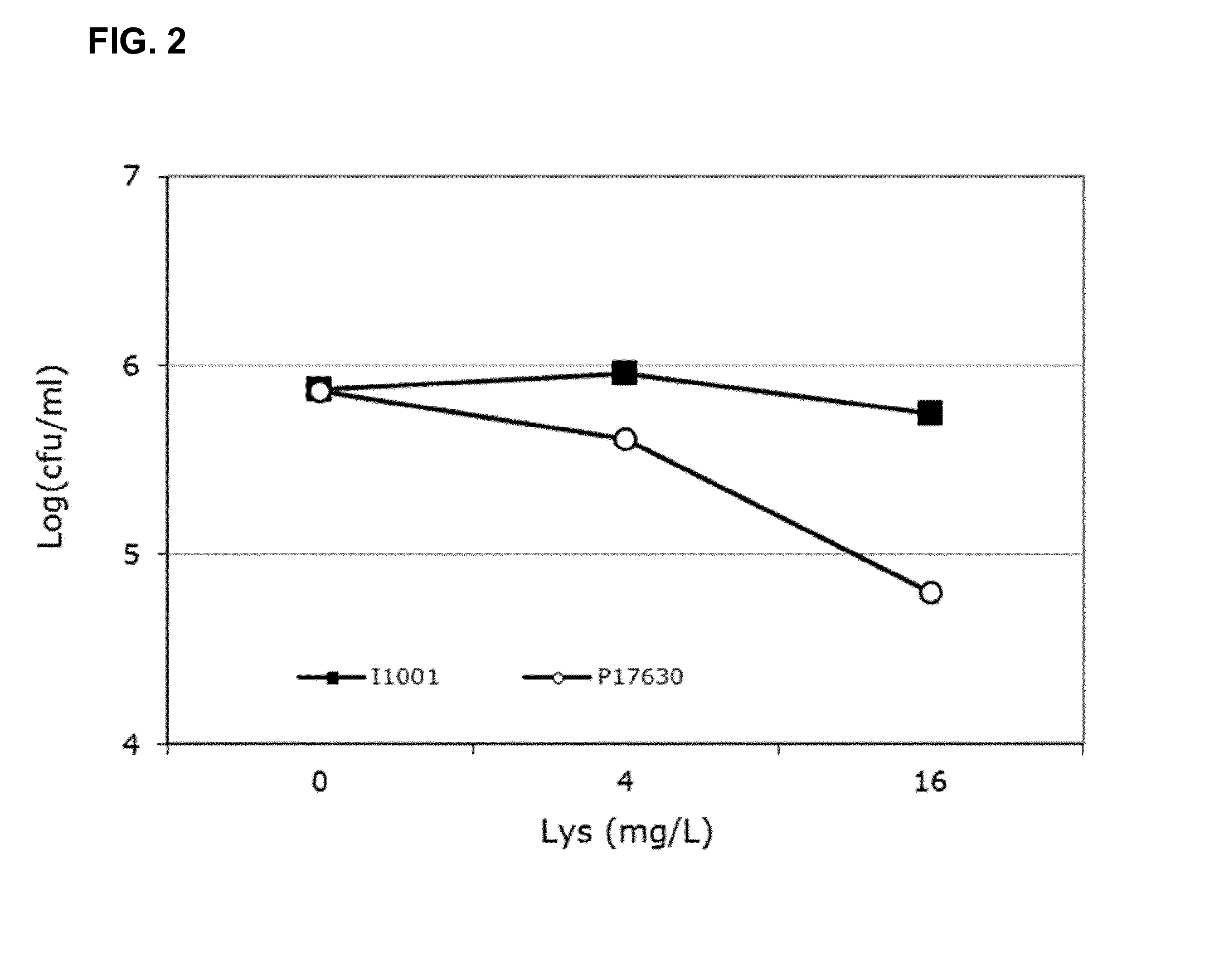Strain of lactobacillus pentosus as probiotic
- Summary
- Abstract
- Description
- Claims
- Application Information
AI Technical Summary
Benefits of technology
Problems solved by technology
Method used
Image
Examples
example 1
Isolation of the Microorganism
[0071]Strain CECT 7504 was isolated from vaginal swabs from healthy young women aged 14-21 years old living under poor hygienic conditions. Samples were dissolved in PBS buffer pH 7.4, aliquoted and plated on different media for incubation under different conditions. Incubation time depended on the growth rate of the strain and run normally from 24 h to 3 days. Isolation of individual strains proceeded with the same selection media, then Gram staining and microscopic examination tests were performed for its initial characterization.
[0072]The strain was initially grown in MRS medium supplemented with 100 μg / l novobiocin (Sigma), 5 μg / mlnystatin, 5 μg / ml cyclohexamide (Sigma), 1 mg / l ampicillin and 10 μg / ml vancomycin, and incubated at 30° C. under anaerobic conditions and pH 6.4. Gram staining showed a clear Gram positive staining, as well as non-spore-forming bacilli morphology.
example 2
Taxonomic Characterization of Strain
[0073]Bacteria were harvested, washed and resuspended in pre-lysis buffer (480 ml EDTA 50 mM, pH 8.0; 120 ml lysozyme 10 mg / ml) at 37° C. for 60 min. DNA was extracted using Wizard genomic DNA purification kit (Promega). After centrifugation of the pre-treated bacteria at 14000 g for 2 min to remove the supernatant, the Promega's protocol was followed. In brief, bacteria were resuspended in Nuclei Lysis Solution and incubated at 80° C. for 5 min, then cooled to room temperature. Cell lysates were incubated in RNase solution at 37° C. for 60 min and proteins were precipitated by adding the Protein Precipitation Solution and vortexing at high speed. Samples were cooled down and centrifuged at 15000 g for 3 min. The supernatants containing the DNA were transferred to clean 1.5 ml microfuge tubes and mixed with 600 ml of isopropanol by inversion. DNA was collected by centrifugation at 15000 g for 2 min and carefully pouring off the supernatant. DNA sa...
example 3
Resistance to the Vaginal Fluid
[0080]The vaginal fluid contains a large variety of antimicrobial factors which act by different mechanisms, such as acidic pH, lysozyme, lactoferrin and defensins. Therefore, demostrating that a bacterial strain is able to survive in an acidic environment (Dho, G., et al. Microbial characteristics of Lactobacillus plantarum P17630 contained in vaginal suppositories. GIMMOC. 2003. Vol. VII, No. 2, pages 102-8) is not sufficient guarantee that this strain will be able to survive in vaginal environment, because it contains other antimicrobial factors in addition to acidic pH.
Vaginal Fluid (Synthetic)
[0081]A vaginal fluid simulant was used (Owen, D. H. et al. A vaginal fluid simulant. Contraception. 1999, Vol. 59, No. 2, pages 91-5), to which antibacterial proteins and peptides were added: 3.5 g / l NaCl, 1.4 g / l KOH, 0.22 g / l Ca(OH)2, 0.02 g / l BSA, 2 g / l lactic acid, 1 g / l acetic acid, 0.16 g / l glycerol, 0.4 g / l urea and 5 g / l glucose. pH was further adjus...
PUM
| Property | Measurement | Unit |
|---|---|---|
| Antimicrobial properties | aaaaa | aaaaa |
| Strain point | aaaaa | aaaaa |
Abstract
Description
Claims
Application Information
 Login to View More
Login to View More - R&D
- Intellectual Property
- Life Sciences
- Materials
- Tech Scout
- Unparalleled Data Quality
- Higher Quality Content
- 60% Fewer Hallucinations
Browse by: Latest US Patents, China's latest patents, Technical Efficacy Thesaurus, Application Domain, Technology Topic, Popular Technical Reports.
© 2025 PatSnap. All rights reserved.Legal|Privacy policy|Modern Slavery Act Transparency Statement|Sitemap|About US| Contact US: help@patsnap.com



